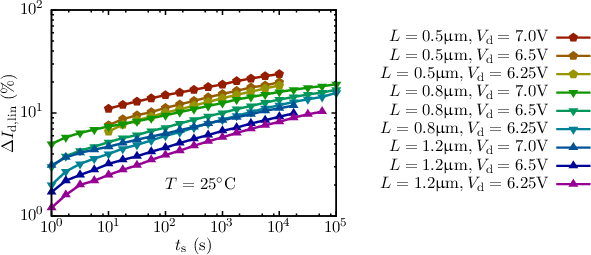7.4 Channel Length Dependence
In Figure 7.6 the ΔId,lin over time during hot-carrier stress in the linear regime of various n-channel
MOSFETs with different channel lengths is shown. From this figure and the literature
[180], it can be concluded that hot-carrier stress is a severe problem in short channel
devices too. This can be explained in terms of the charge carrier energy distribution and is
still an active area of research. As discussed for the temperature dependence, in shorter
channels the charge carriers can accelerate without being scattered as much as in a long
channels. This reduction in the number of scattering events per second in scaled MOSFETs
reinforces the cumulative probability of the carrier ensemble to dissociate Si-H bonds at the
semiconductor-oxide interface, since there are more carriers with sufficient kinetic energy.
Additionally, electron-electron scattering is more pronounced in shorter channel devices,
where more carriers exceed the threshold to significantly elevate the high energy tail of the
distribution function than in long channel devices. In summary the average number of
hot electrons is increased by electron-electron scattering, which has a significant influence
especially for shorter channel devices, since the carriers scatter less with phonons and
impurities.
